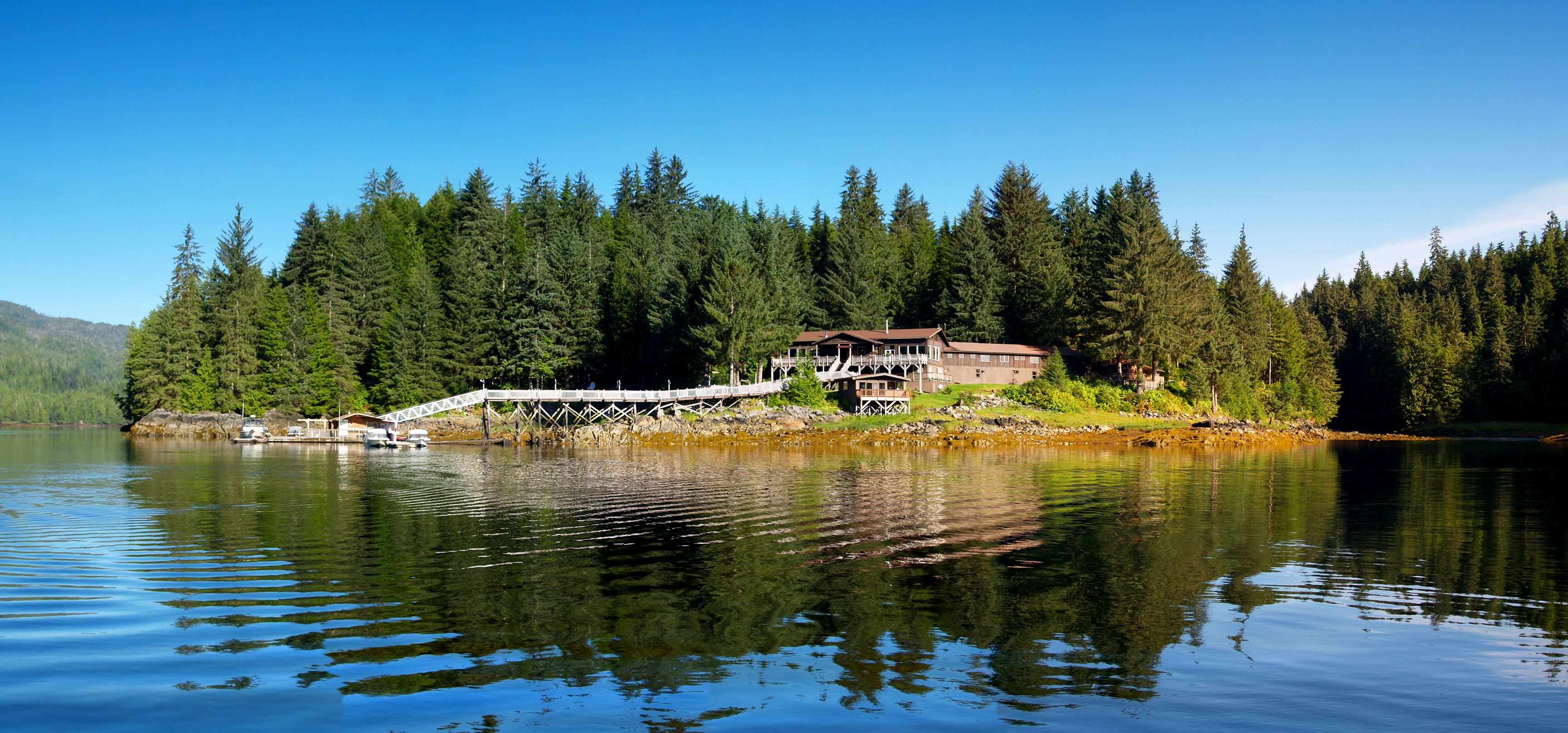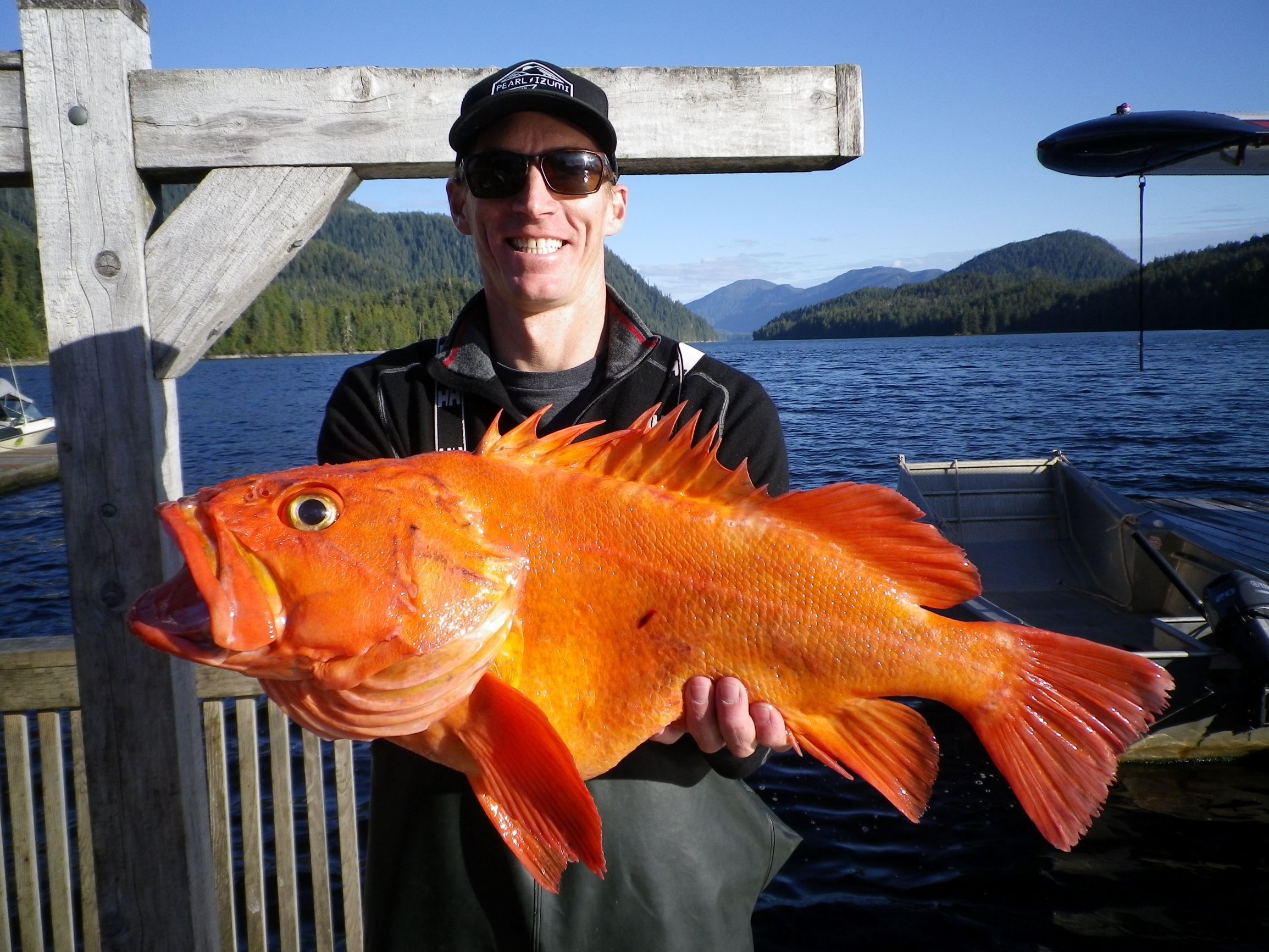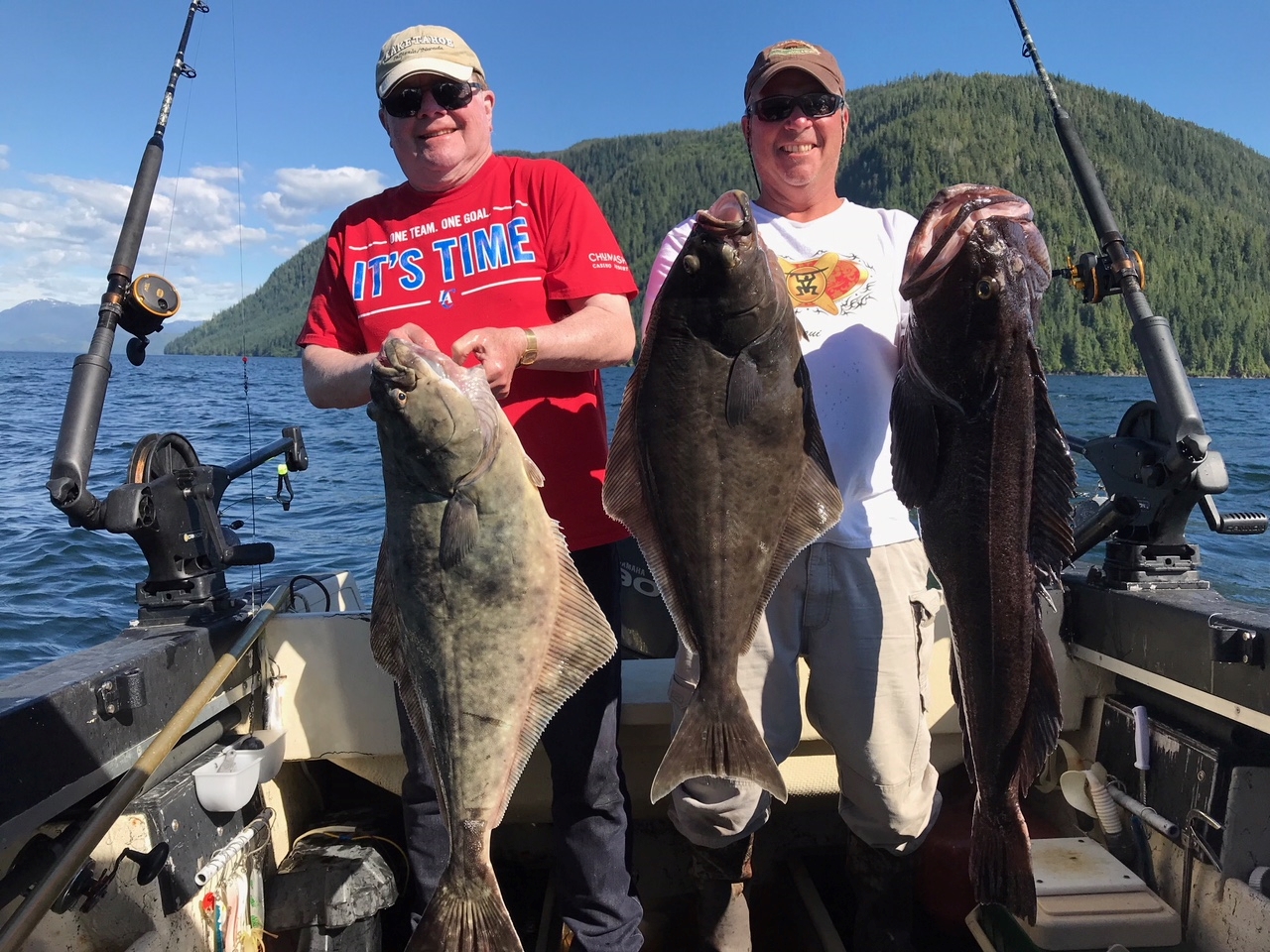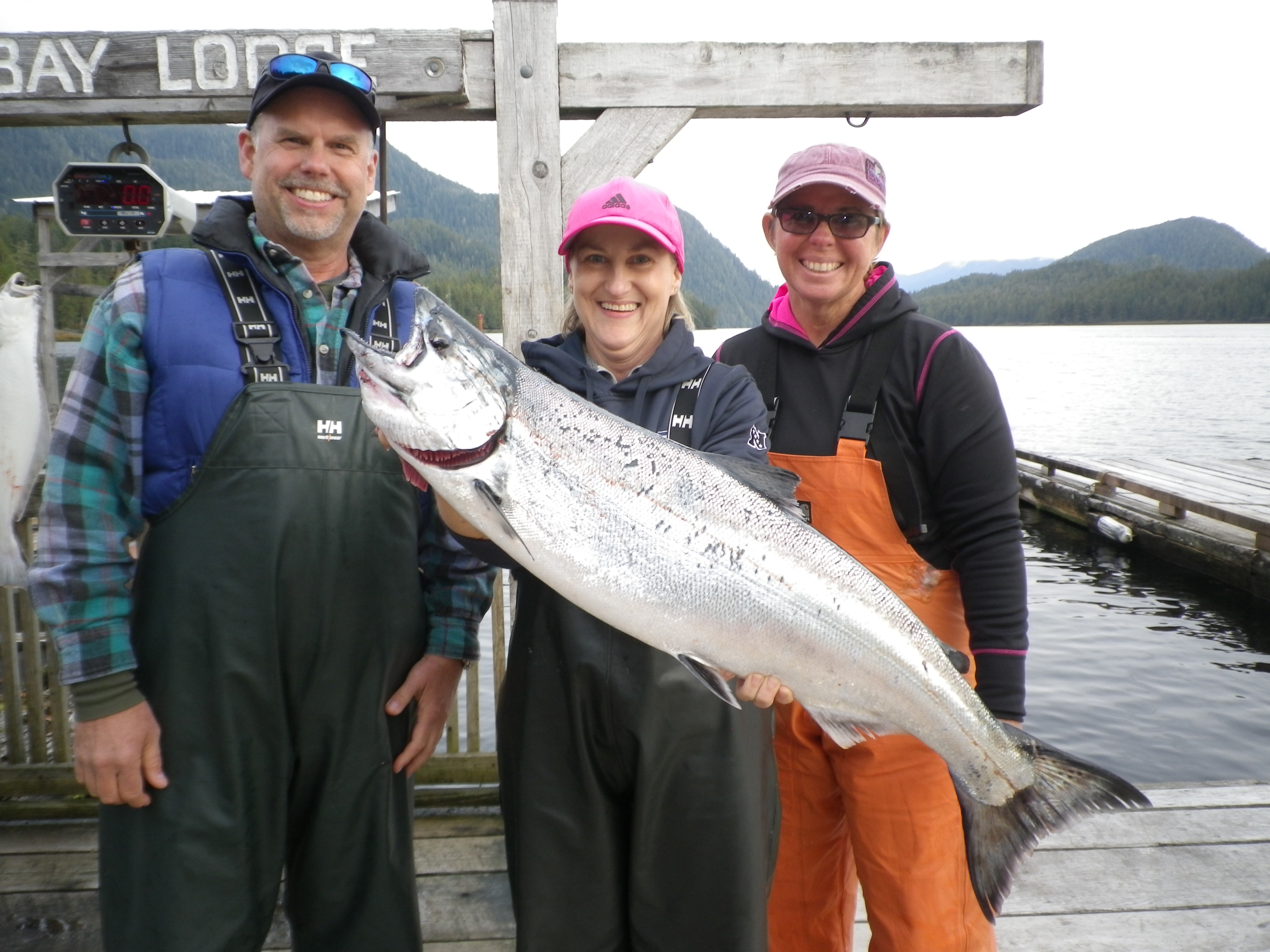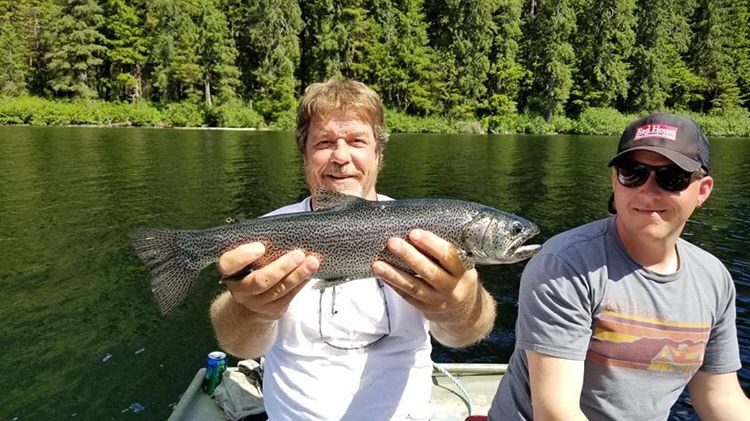Meet Our Fish!
We are fortunate to have all 5 species of salmon around Yes Bay.
We primarily only fish for 4 – we have a huge sockeye run in the creek by the Lodge, however they typically do not feed on trolled bait, the prefer to eat plankton and jellyfish, so we do not target them. One or two have been caught over the years on hook and line.
A red fly in front of the Lodge in the creek can produce a fish, a fun evening activity.
KING (Chinook) SALMON: Alaska’s state fish is the largest species of salmon, weighing on average 20-40 pounds and between 3-4 feet long. The spawning male is colored red to black, depending on the maturation, and has a hooked upper jaw. The spawning female has similar but not as pronounced coloring as the male. Kings spend 2-6 years in saltwater before spawning. The major spawning areas are the Unuk River and the Chickamin River, located on the back side of Revillagigedo Island, around the corner of the Behm Canal. Yes Bay guests fish the western Behm Canal from May to early July for this run.

SOCKEYE (Red) SALMON: Sockeyes average 3.5-4 lbs. and are 1.5-2 feet long. The spawning male and female turn a brilliant red through the body with a pale green head and upper jaw. The male develops a humped back and elongated, hooked upper jaw. Sockeye spend 1-4 years in saltwater before spawning. They can be caught on a fly in Wolverine Creek, McDonald drainage, and Shrimp Bay the end of July through August.  PINK (Humpy) SALMON: Pinks average 3.5-4 lbs. and are 1.75-2 feet long. The spawning male is brown / black, with a white belly, a large hump on its back, and hooked jaws. The spawning female is olive green with dusky patches, and has a white or light colored belly. Pinks spend 2 years in saltwater before spawning. The Neets Bay Hatchery raised pinks for a few years, but have recently switched to raising chums. Pinks can still be found in the Neets Bay area through July and August
PINK (Humpy) SALMON: Pinks average 3.5-4 lbs. and are 1.75-2 feet long. The spawning male is brown / black, with a white belly, a large hump on its back, and hooked jaws. The spawning female is olive green with dusky patches, and has a white or light colored belly. Pinks spend 2 years in saltwater before spawning. The Neets Bay Hatchery raised pinks for a few years, but have recently switched to raising chums. Pinks can still be found in the Neets Bay area through July and August

CHUM (Dog) SALMON: Chum average 7-18 lbs. and are 2-2.5 feet long. Trophy size is over 15 lbs. The spawning male has green and purple bars with a hooked jaw and large teeth. The spawning female has a dark horizontal band with green and purple bars which are less defined than males. Chums spend 2-3 years in saltwater before spawning. Due to the tremendous success of the Neets Bay Hatchery, the run is increasing every year. For example, in 1996, guests were fishing in a school of about 2 million chums in the Neets Bay area. Guests enjoy fishing for them in the saltwater and in the streams. They are most plentiful in July and August

SILVER (Coho) SALMON: Cohos average 8-12 lbs. and are 2-2.5 feet long. Spawning males and females have dark backs and heads and reddish sides. Males have a prominent hooked jaw. Silvers spend 1-2 years in saltwater before spawning. They begin arriving around mid-August, and run through the end of September. Among the 15-20 rivers where these salmon spawn, they are mainly running to Chickamin River, Unuk River, Cow Creek, Grand Creek, Herman Creek, McDonald Lake, and Reflection Lake, near Yes Bay.

HALIBUT: Halibut is the most popular bottom fish and can weigh from 15 to over 100 pounds. Adults can weigh over 300 pounds, and live up to 20 years. They are available throughout the season with a peak during July and August. During winter months, they migrate to open ocean to spawn. Young halibut are born with eyes on each side of their head. As they mature, one eye migrates to the darkest side of the body. They lay in sand or gravel bottoms on the white side of their body. The darker side of their body blends with the ocean bottom to make them virtually invisible to predators. Guests fish for halibut 5-20 minutes from the lodge at the mouth of Yes Bay, Western Behm Canal, Spacious Bay, Gedney Pass, and Behm Narrows

Rockfish are Alaska’s only sport fish that contain venom in their spiny fins. But despite being mildly toxic to the touch, most of the species have a delicious white meat. Rockfish species, 32 in all, can be individually unique; some are colored dark black while others are entirely hot orange. Incredibly, some yelloweye rockfish are known to live up to 140 years old. The large family of fish is also ovoviviparous, meaning they give birth to live young rather than eggs. The most sought after are the yelloweye, quillback, dusky, copper and black rockfish. There are 32 different species of rockfishes, which can vary between 4 to 41 inches in length. The overall average length is between 20 and 24 inches. The body of a rockfish is armed with venomous spines on its head and body alongside various bony plates. As a predator, the fish have a large mouth and large pelvic fins for easy maneuvering. To small undersea attackers, the venom of a rockfish can be deadly; however, to creatures as large as man it is only mildly toxic. In general, most rockfish resemble bass or perch and are sometimes called sea bass.

RAINBOW TROUT: Rainbows commonly reach up to 18 inches long. They are known for the red stripe along their lateral side. Rainbows are available in all of the streams in Alaska for catch and release fishing. Rainbow trout have very small, fine scales on their torpedo-shaped body. They have silvery sides with a horizontal pinkish band that varies in intensity in different populations. The back is bluish to greenish with black spots on the back and sides. Rainbows have no teeth on the tongue. Rainbow trout belong to the family of fish known as salmon and are characterized by adipose fins. The caudal fin is not forked, and has radiating rows of black spots.

CUTTHROAT TROUT: Cutthroats are green with white specs, and have two red slashes under their gills. Trophy fish weigh over 3 pounds. Cutthroats are available in all of the streams for catch and release fishing. The coastal cutthroat trout is unlike most of the other salmon Species, because it may spawn more than once. Adults commonly enter streams during the fall and feed on the eggs from other salmons’ spawn. Like other salmon, the female cutthroat digs a nest or redd and the male fertilizes the eggs. Spawning can occur from December through May, dependent upon the water conditions. The female cutthroat can lay from 200 to 4,400 eggs, which hatch in about 1 month. The young spend 1 to 2 weeks in the gravel before emerging. Young cutthroat can spend 1 to 9 years in fresh water before they migrate to the estuaries and ocean in the spring, most commonly three years from emergence. Coastal cutthroat trout usually spend less than 1 year in salt water before returning to spawn

